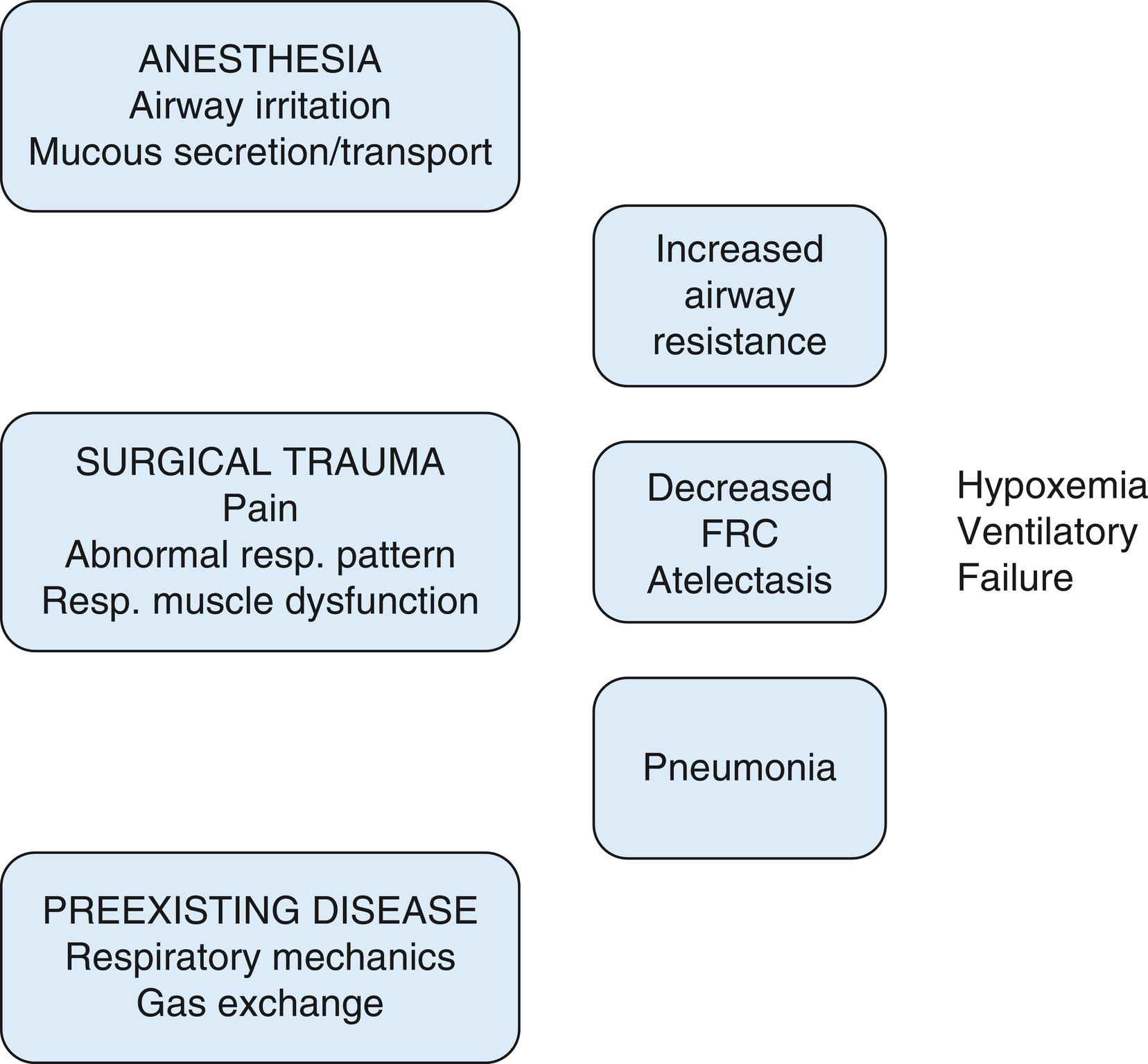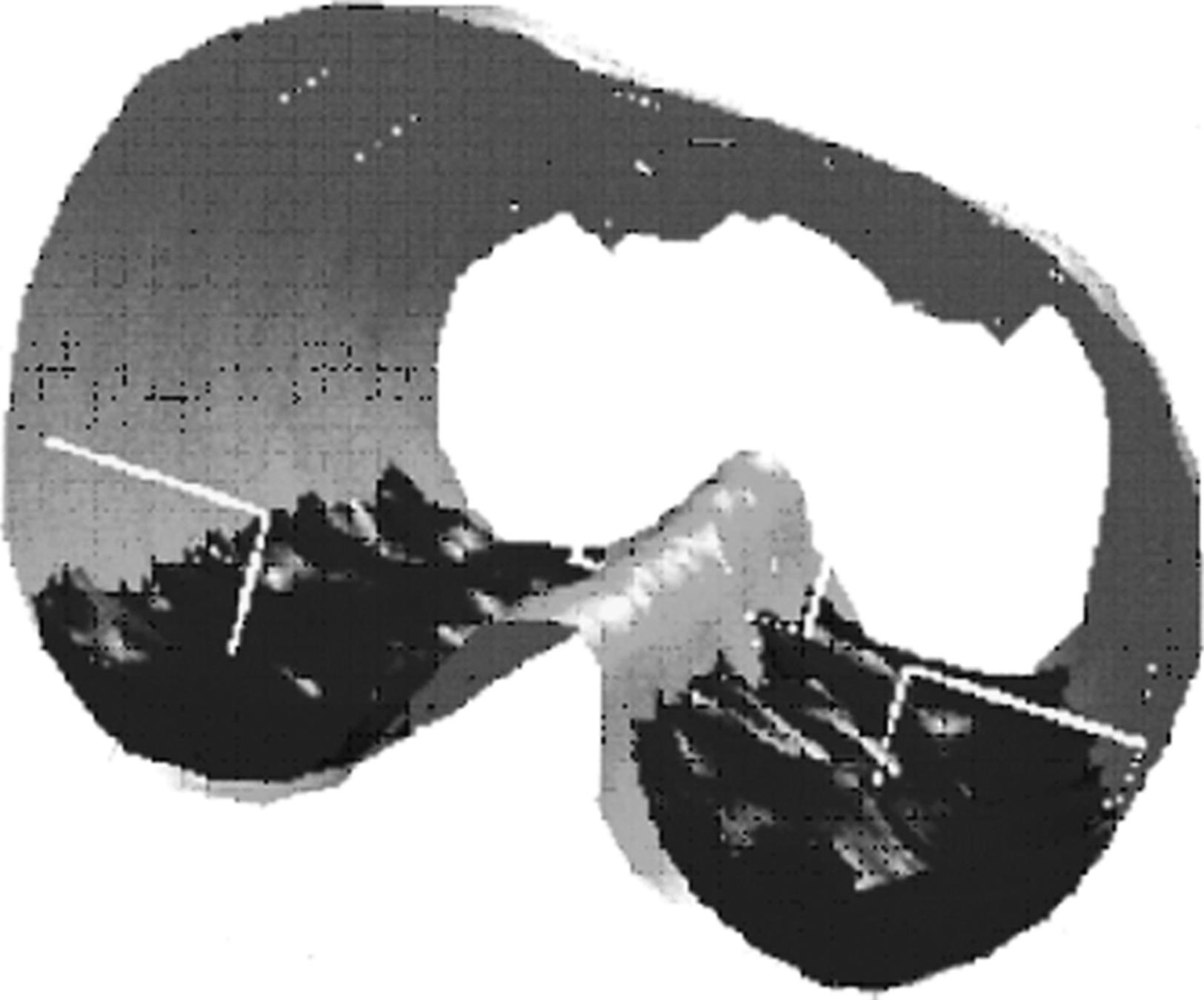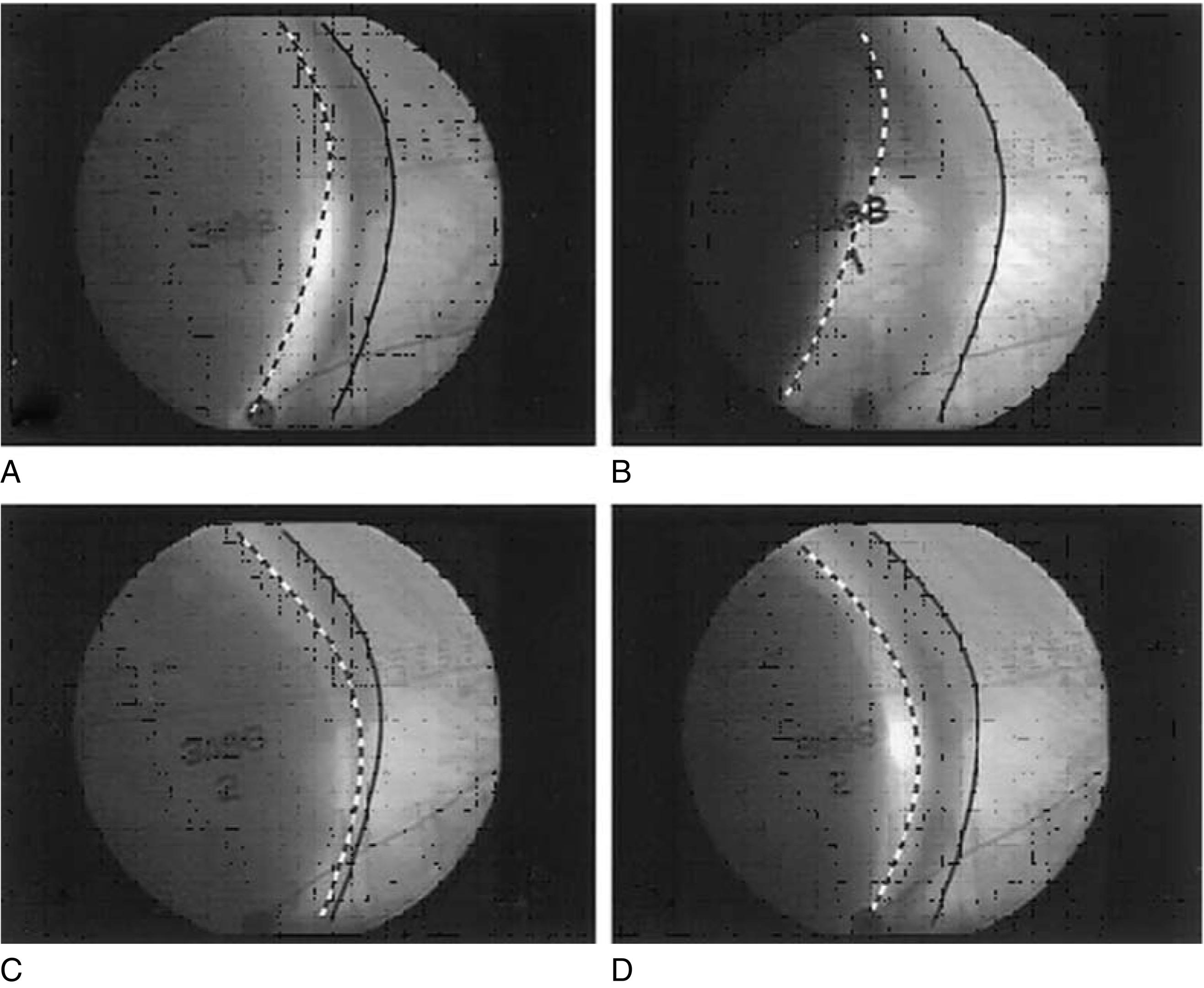Physical Address
304 North Cardinal St.
Dorchester Center, MA 02124
Postoperative pulmonary complications (PPCs) have undeniable clinical relevance because they are frequent and impose a significant burden of perioperative morbidity and mortality. The reported incidence of PPCs varies considerably among studies, from 2% to 40%, with several risk factors identified ( Table 9.1 ). Ambiguities in the definition of PPCs and lack of systematic studies have created more challenges to the perioperative pulmonary risk evaluation. However, in the last decade, definitions were improved and risk factors were comprehensively analyzed and included in validated outcome prediction models.
| Strong evidence a | Fair evidence a | Indeterminate | |
|---|---|---|---|
| Patient-related factors | Advanced age | History of smoking | Respiratory infection in the last month |
| ASA class > 2 | Impaired sensorium | GERD | |
| Congestive heart failure | Weight loss | Alcohol use | |
| Functional dependence | Alcohol use | Diabetes mellitus | |
| COPD | Weight loss | ||
| Obesity | |||
| Moderate/severe obstructive sleep apnea | |||
| Hypertension | |||
| Liver disease | |||
| Cancer | |||
| Sepsis | |||
| Asthma | |||
| Renal failure | |||
| Ascites | |||
| Diabetes mellitus Preoperative shock |
|||
| Procedure-related factors | Aortic aneurysm | Transfusion | Prolonged hospitalization |
| Thoracic | Procedures with a high risk for ALI/ARDS | ||
| Abdominal | Procedures with a risk for UEPI | ||
| Upper abdominal | Perioperative nasogastric tube | ||
| Neurosurgery | Use of long-acting neuromuscular blockers | ||
| Prolonged surgery (> 3 hours) | Mechanical ventilation strategy | ||
| Head and neck | Open abdominal surgery (vs. laparoscopic) | ||
| Emergency | Neostigmine | ||
| Vascular | Failure to use peripheral nerve stimulator | ||
| General anesthesia | |||
| Blood transfusion | |||
| Lab/preoperative testing | Low serum albumin | Chest radiograph | Positive cough test |
| Blood urea | Low preoperative oxygen saturation | ||
| Anemia | |||
| Generic variations | |||
| Increased creatinine | |||
| Abnormal liver function test results | |||
| Predicted maximal oxygen uptake | |||
| FEV 1 /FVC < 0.7 and FEV 1 < 80% of predicted |
a Adapted from Smetana GW, Lawrence VA, Cornell JE. American College of Physicians: Preoperative pulmonary risk stratification for noncardiothoracic surgery: systematic review for the American College of Physicians. Ann Intern Med 2006;144(8):581.
Approximately 1 million surgical patients have PPCs each year in the United States. Studies have shown that PPCs occur in 2%–12% of nonthoracic surgeries and in up to 38% of thoracic surgeries. In patients after major abdominal surgery, the incidence of PPCs was around 6%.
In a multicenter study, the 30-day mortality was estimated to be 19.5% in those with PPC as opposed to 0.5% in those without a PPC. A prospective cohort study on patients undergoing nonthoracic surgery showed that patients who developed a PPC had a mean hospital stay of 27.9 days as opposed to a mean value of 4.5 days in patients who did not have a PPC.
A study on US Medicare beneficiaries showed that pneumonia and respiratory failure respectively account for 2.8% and 1.4%, respectively, of causes of rehospitalization after surgery. The American College of Surgeons National Surgical Quality Improvement Program (ACS-NSQIP) analyzed Medicare inpatient claims and found that preventing postoperative complications would avoid 41,846 readmissions and save $620 million of public health expense every year.
Early studies lumped events with questionable clinical relevance, such as intraoperative bronchospasm or low-grade fever, together with more significant complications, such as pneumonia and respiratory failure. A more systematic approach should evaluate only those complications that are likely to affect mortality, prolong hospital stay, or require specific treatment. These clinical entities should be defined by criteria as stringent and univocal as possible, such as the criteria for nosocomial pneumonia. However, the reported rate of pulmonary complications is variable even when stricter criteria for the diagnosis of PPCs are used, probably due to the heterogeneity of the populations studied and of the surgical procedures performed ( Table 9.2 ). The large variability among studies is also due to difficulty in discriminating each of the complications because they have interdependent pathways.
| Procedure-related risk factor | Adjusted OR for PPCs (95% CI) | PPC rate a (%) |
|---|---|---|
| Surgical site | ||
|
6.90 (2.74–17.36) | – |
|
2.10 (0.81–5.42 | 25.5 |
|
2.21 (1.82–2.68) | 10.3 |
|
4.24 (2.89–6.23) | – |
|
– | 18.9 |
|
– | 19.7 |
|
– | 5.1 |
|
– | 7.7 |
|
2.53 (1.84–3.47) | – |
|
– | 1.8 |
|
2.26 (1.47–3.47) | – |
|
2.52 (1.69–3.75) | – |
|
2.35 (1.77–3.12) | – |
a After multivariable adjustment for other patient-related and procedure-related risk factors.
Pneumonia is probably the single most important PPC because it has a definitive impact on outcomes. Postoperative pneumonia has been detected in 18.6% of 140 patients undergoing major surgery and is associated with mortality rates as high as 21%. Perioperative bronchospasm seems to occur in a surprisingly small portion of the population, even when patients with asthma are considered. However, bronchospasm was the most frequent complication in smokers with evidence of airway obstruction by spirometry. Recently, the European Perioperative Clinical Outcome definitions included a universal definition of PPCs with a comprehensive list of components ( Table 9.3 ).
| Measure | Definition by Canet et al. 2010 | Other definition |
|---|---|---|
| Respiratory failure | Postoperative PaO 2 < 60 mmHg on room air, a ratio of PaO 2 to FiO 2 < 300, or arterial oxyhemoglobin saturation measured with pulse oximetry < 90% and requiring oxygen therapy | Requires invasive or noninvasive mechanical ventilation |
| Suspected pulmonary infection | Treatment with antibiotics for a respiratory infection, plus at least one of the following criteria: | Clinical diagnostic criteria for nosocomial pneumonia |
| New or changed sputum | ||
| New or changed lung opacities on a clinically indicated chest radiograph | ||
| Temperature > 38.3°C | ||
| Leukocyte count > 12,000/mm 3 | ||
| Atelectasis | Suggested by lung opacification with shift of the mediastinum, hilum, or hemidiaphragm toward the affected area and compensatory overinflation in the adjacent nonatelectatic lung | Requires intervention (bronchoscopy, postural therapy) |
| Aspiration pneumonitis | Respiratory failure after the inhalation of regurgitated gastric contests | |
| Pneumothorax | Air in the pleural space with no vascular bed surrounding the visceral pleura | Requires drainage |
| Pleural effusion | Chest radiograph demonstrating blunting of the costophrenic angle, loss of the sharp silhouette of the ipsilateral hemidiaphragm | Requires drainage |
| Bronchospasm | Newly detected expiratory wheezing treated with bronchodilators | Requires bronchodilator therapy |
| ARDS | Acute onset < 1 week, bilateral infiltrates on CXR, hypoxemia as evidenced by PaO 2 /FiO 2 < 300, minimal evidence of left atrial fluid overload, PCWP < 18 cm H 2 O | |
| Tracheobronchitis | Purulent sputum with normal chest radiograph, no IV antibiotics | |
| Pulmonary edema | Pulmonary congestion/hypostasis, acute edema of lung, congestive heart failure | |
| Exacerbation of preexisting lung disease | Not further defined | |
| Pulmonary embolism | Not further defined |
The mechanisms leading to PPCs are complex and only partially understood. Factors related to preexisting diseases, surgical trauma, and anesthesia interact in predisposing a patient to the development of PPC ( Fig. 9.1 ). Perioperative loss of lung volumes with consequent formation of atelectasis is widely accepted as one of the most important mechanisms leading to PPC. Atelectasis is initiated during anesthesia and mechanical ventilation and deteriorates gas exchange intraoperatively and in the early postoperative period. Using computed tomographic scans of the chest, Hedenstierna et al. observed small areas of alveolar collapse shortly after the induction of general anesthesia in healthy subjects but could not demonstrate the same phenomenon in patients receiving epidural anesthesia. The causes of the formation of atelectasis during general anesthesia are multiple. Lung tissue has a natural tendency to display gravity-dependent alveolar collapse during mechanical ventilation, as suggested by the fact that atelectasis is located in the recumbent parts of the lungs ( Fig. 9.2 ). Mechanical ventilation and muscle relaxation cause cephalad displacement and decreased respiratory excursion of the posterior part of the diaphragm, a finding that explains the dominant caudal distribution of the areas of atelectasis ( Fig. 9.3 ). High fraction of inspired oxygen and lower pulmonary distending pressures predispose to dependent airway closure and subsequent absorption atelectasis. The three mechanisms postulated for atelectasis during general anesthesia are compression of lung tissue, absorption atelectasis, and loss of surfactant.



Functional residual capacity declines after surgery, and the observed changes are bigger when the site of surgical incision is closer to the diaphragm. Pain and surgical trauma lead to limitation of inspiratory excursion and are important contributors to postoperative lung volume loss. Pain in the immediate postoperative period causes spinal reflex inhibition of the phrenic nerve due to nociceptive inputs to ventral and ventrolateral horns of the spinal cord, which affect the diaphragm function. There is also evidence that surgical manipulation of upper abdominal viscera results in a reflex dysfunction of the diaphragm muscle that is not related to pain, as shown in patients after laparoscopic cholecystectomy. Atelectasis is considered a relevant complication in itself, because it can cause hypoxemia and respiratory failure and also because it could predispose to pneumonia. However, a causative link between atelectasis and pneumonia remains undemonstrated. Experimental data showed limited bacterial growth following alveolar recruitment in an animal model of pneumonia, suggesting that collapsed lung provides a favorable environment for infection.
In addition to volume loss, other factors play a role in the genesis of PPC and of postoperative pneumonia. An important factor is probably mucous retention caused by decreased coughing resulting from pain and medications and by dysfunction of mucociliary transport in the airway mucosa. Mucociliary transport is an important mechanism of pulmonary defense, and its velocity is decreased by anesthesia and by endotracheal intubation with a cuffed tube. Smokers have a decreased mucociliary transport velocity during anesthesia compared with nonsmokers, a finding that may help to explain the high rate of PPC in these patients. It is not clear how long this functional impairment of mucous transport lasts after the end of anesthesia and extubation.
Aspiration of contaminated oropharyngeal secretions is thought to be a prominent mechanism leading to nosocomial and postoperative pneumonia. Residual subclinical muscle relaxation has been detected in patients who received long-acting muscle relaxants, and it was associated with an increased rate of pulmonary complications. Residual effects of neuromuscular blockers cause atelectasis in the postanesthesia care unit. Residual blockade is defined as a train-of-four ratio of < 0.9, which is associated with lower values of forced vital capacity and of peak expiratory flow rate as measured by pulmonary function testing (PFT). Poor airway protection and aspiration of secretions are probably even more common after certain procedures, such as transhiatal esophagectomy, explaining the 28.5% rate of PPCs observed after this surgery.
Finally, chronic obstructive pulmonary disease (COPD) causes gas exchange and respiratory mechanics abnormalities that reduce the patients’ ability to tolerate superimposed acute lung disease and render them prone to respiratory failure. Additionally, patients with COPD have dysfunction of the respiratory muscles due to chest wall deformation and to myopathy. These patients may be unable to withstand the increased ventilatory demand and the higher work of breathing required in the postoperative period and may require ventilatory support earlier than patients with normal muscle function.
The preoperative pulmonary evaluation is an integral part of the general preoperative risk assessment. The evaluation should start by collecting information on the patient’s overall health status, then focus on the respiratory system and include a careful exam.
The majority of patients undergoing nonthoracic procedures are less likely to benefit from instrumental testing. They should proceed to have surgery, have it postponed, or have it denied without further evaluation. This approach should be the same, regardless of the type of planned surgery, and differs from the evaluation of the patient candidate for pulmonary resection, which is discussed later in this chapter.
For better understanding, the risk factors for PPC are grouped into patient factors and operative factors. Patient factors include pulmonary and extrapulmonary factors, while the operative factors include anesthesia and surgical factors, which are discussed separately.
Become a Clinical Tree membership for Full access and enjoy Unlimited articles
If you are a member. Log in here